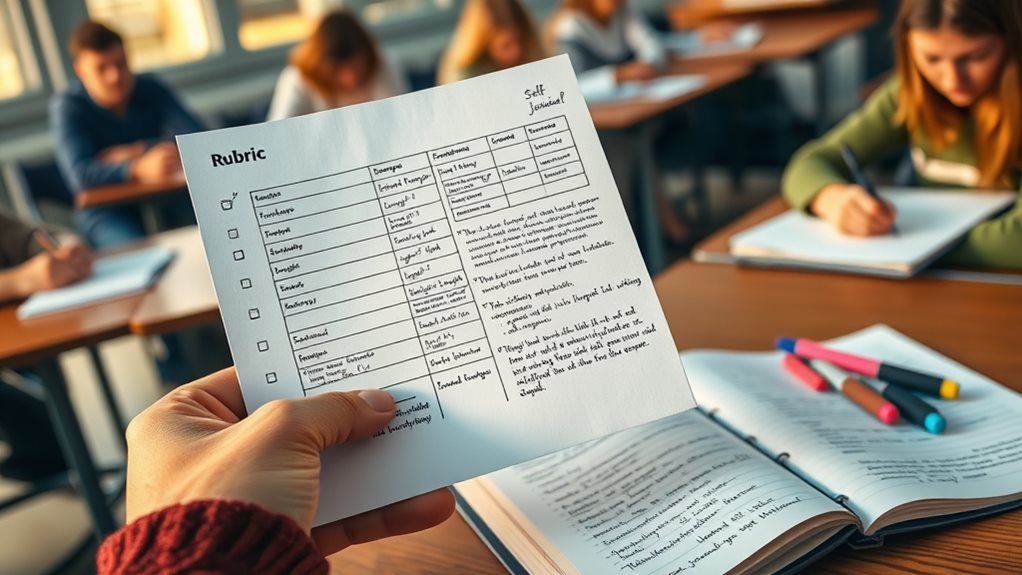Rubrics help you reflect on your learning by breaking tasks into clear criteria. They encourage self-assessment, allowing you to analyze strengths and areas for improvement. By using rubrics, you'll develop critical thinking and metacognitive skills, understanding your own thought processes better. Co-creating rubrics with peers fosters ownership and aligns them with your goals. Regular feedback from rubrics guides continuous growth, making learning more intentional and effective. Sticking with this approach unlocks deeper insights into your progress.
The Role of Rubrics in Student Reflection

When you introduce rubrics into your classroom, you're not just handing students a grading tool—you're equipping them with a powerful framework for reflection. Rubrics break down complex tasks into specific, measurable criteria, giving students a clear roadmap for self-assessment. This process encourages them to critically analyze their work, identify strengths, and pinpoint areas for improvement.
Imagine the confidence they'll gain when they can objectively evaluate their own progress, rather than relying solely on your feedback.
Rubrics also foster metacognition, helping students become more aware of their own thinking and learning processes. By answering reflective questions tied to the rubric criteria, they're pushed to think deeply about how they approached a task, what strategies worked, and where they might need to adjust. For example, if a rubric asks, "Did you organize your ideas logically in your essay?" your students aren't just checking a box—they're reflecting on their organizational skills and considering how to enhance them.
Research shows that this self-assessment process leads to tangible improvements. Students who regularly use rubrics, particularly in writing, often see significant boosts in their performance. Why? Because they're no longer guessing what "good" looks like—they have a concrete set of standards to guide them. This clarity reduces anxiety and empowers them to take ownership of their learning.
Take it a step further by involving students in co-creating rubrics. When they help define the criteria, they become more invested in the process. They'll understand the "why" behind each standard, which deepens their connection to their work and encourages more meaningful reflection.
Finally, rubrics aren't just about evaluation—they're a feedback mechanism. When students reflect on their scores, they gain insights into their learning journey. They can see where they're excelling and where they need to focus, making their next steps clear and actionable.
Key Benefits of Rubrics for Reflection:
- Clarity: Provides specific criteria for self-assessment.
- Metacognition: Encourages students to analyze their own thinking and learning.
- Ownership: Involves students in the creation process for greater investment.
- Feedback: Acts as a guide for future improvement.
Enhancing Critical Thinking Through Rubrics
Want to take your students' critical thinking skills to the next level? Rubrics are your secret weapon. You'll see immediate improvements when you incorporate them into your teaching strategy. The key lies in how rubrics break down complex tasks into clear, actionable criteria.
By providing students with a detailed framework, you're giving them the tools to analyze their own work objectively. This self-assessment process is where the magic happens. Students don't just receive feedback—they learn to evaluate their own performance, identify gaps, and strategize improvements.
Consider this: when students use rubrics, they're forced to think critically about each component of their work. For example, if you're assessing an essay, the rubric might include criteria like thesis clarity, evidence quality, and argument structure. This forces students to ask themselves, "Does my thesis make a strong, debatable claim? Are my sources credible? Does my argument flow logically?"
Here's why this matters:
- Rubrics encourage students to articulate their reasoning, which deepens their understanding of the subject.
- They promote metacognitive skills, helping students reflect on their learning process.
- Research shows that students who use rubrics for self-assessment consistently perform better on follow-up tasks.
But it's not just about better grades. Rubrics empower students to take ownership of their learning. When they can see exactly where they excel and where they need improvement, they feel more in control. This sense of agency boosts motivation and drives academic success.
So, how can you make the most of rubrics? Start by co-creating them with your students. Involve them in defining the criteria and levels of quality. This not only ensures clarity but also fosters buy-in.
Then, use rubrics consistently—not just for grading, but as a guide throughout the assignment process. Encourage students to refer back to the rubric as they work, and use it as a tool for peer review and self-reflection.
In short, rubrics aren't just assessment tools—they're a pathway to deeper learning and sharper critical thinking. When you use them effectively, you're not just teaching content; you're equipping students with skills that will serve them long after they leave your classroom.
Building Metacognitive Skills With Rubrics

Using rubrics for self-assessment isn't just about grading—it's a powerful tool to build your metacognitive skills. When you engage with rubrics, you're not passively receiving feedback; you're actively reflecting on your work, identifying gaps, and strategizing improvements. This process sharpens your critical thinking and deepens your understanding of the material.
Here's how rubrics help you develop metacognition:
- They provide clarity: Rubrics break down complex tasks into specific criteria. By comparing your work against these standards, you gain a clear picture of what you've mastered and where you need to focus.
- They foster self-reflection: As you review your work using a rubric, you're forced to articulate your thought process. This reflection helps you recognize patterns in your strengths and weaknesses.
- They encourage accountability: Rubrics shift the responsibility of assessment onto you. Instead of waiting for feedback, you're actively involved in evaluating your progress, which builds independence and self-regulation.
Research shows that students who consistently use rubrics for self-assessment experience significant improvements in both content mastery and skill development. For example, if you're working on a writing assignment, a rubric helps you pinpoint whether your argumentation is strong or if your structure needs refinement.
Over time, this practice enhances your ability to self-monitor and revise effectively.
To get the most out of rubrics, use them regularly. Before submitting an assignment, take the time to assess your work against the rubric criteria. Identify specific areas for improvement and make targeted revisions. This habit not only boosts your performance but also strengthens your metacognitive awareness, making you a more effective learner in the long run.
Strategies for Effective Rubric Implementation
To effectively implement rubrics for student reflection, start by co-creating them with your students. This collaborative approach fosters ownership of their learning and increases investment in the assessment process. When students have a hand in defining the criteria, they're more likely to understand and engage with it, which enhances motivation and performance outcomes.
Keep your rubrics simple and clearly aligned with learning objectives. Complicated rubrics can overwhelm students and dilute their ability to self-assess. Focus on the essential criteria that directly reflect what you want them to learn. This clarity ensures students can easily interpret the rubric and apply it to their work.
Introduce rubrics at the start of assignments. Providing them early allows students to use the rubric as a guide during brainstorming and drafting phases. This not only deepens their engagement with the assignment but also helps them internalize the criteria, leading to more thoughtful and polished work.
Incorporate rubrics into peer review sessions. Peer review is a powerful tool for collaborative learning, and using rubrics during this process helps students understand diverse perspectives on quality and expectations. It also encourages them to think critically about their own work through the lens of constructive feedback.
Finally, revisit and refine your rubrics regularly. Solicit student feedback on how well the rubric supports their learning and reflection. Use this input to make adjustments that ensure the rubric remains relevant and effective. A well-crafted rubric evolves alongside your students' needs, promoting continuous growth and meaningful reflection.
- Co-create rubrics with students for ownership and engagement.
- Align rubrics clearly with learning objectives to ensure clarity.
- Introduce rubrics early to guide brainstorming and drafting.
- Use rubrics in peer review to foster collaborative learning.
- Refine rubrics based on student feedback to maintain relevance.
Encouraging Self-Assessment and Goal Setting

Using rubrics for student self-assessment transforms how they engage with their learning. When students evaluate their work against clear criteria, they gain a deeper understanding of their performance. This process isn't just about grading—it's about fostering critical thinking and self-awareness. You'll see them analyze their strengths and pinpoint areas for growth, which is a game-changer for their academic development.
Self-assessment through rubrics also empowers students to set meaningful, actionable goals. Research shows that students who actively assess their work are more likely to create realistic, specific objectives. This isn't just theoretical—it's practical. When students reflect on their progress, they become more motivated and invested in their own success. You're not just teaching them to complete assignments; you're equipping them with skills to take ownership of their learning journey.
Metacognitive skills—thinking about their own thinking—are another major benefit. By using rubrics, students develop the ability to monitor and regulate their learning processes. They'll ask themselves questions like, "Did I meet the criteria?" or "What can I do differently next time?" These moments of reflection lead to deeper understanding and higher-quality outcomes. You're helping them become self-directed learners who can navigate challenges with confidence.
Co-creating rubrics with your students takes this process to the next level. When they're involved in defining the criteria, they're more invested in the assessment process. This isn't just about engagement—it's about empowerment. They'll feel a sense of ownership over their learning and be more committed to achieving their goals. Imagine the impact when students are actively shaping their own success.
- Self-assessment teaches students to critically analyze their work.
- Realistic goal setting becomes second nature.
- Metacognitive skills help them monitor their learning.
- Co-created rubrics increase student investment and ownership.
Aligning Rubrics With Learning Objectives
Aligning rubrics with learning objectives isn't just a best practice—it's a necessity if you want your students to truly succeed. When you ensure that your rubrics directly reflect what students are supposed to learn, you create a clear roadmap for both instruction and assessment. Think of it this way: if your learning objectives are the destination, your rubrics are the GPS guiding students on how to get there.
First, break down each learning objective into measurable performance indicators. For example, if your objective is for students to "demonstrate persuasive writing skills," your rubric should include specific criteria like "use of evidence to support claims," "organization of arguments," and "tone and style." This level of detail ensures students know exactly what's expected and how they'll be evaluated.
Research shows that students perform significantly better when rubrics are closely tied to learning objectives. They're not left guessing what "good" looks like—they can see it clearly laid out in the rubric. This clarity also empowers them to self-assess their work, fostering a deeper understanding of their strengths and areas for improvement.
To keep your rubrics effective, review them regularly. As your learning objectives evolve, so should your rubrics. For instance, if you introduce a new technology tool in your curriculum, update your rubrics to reflect proficiency in its use. This ensures your assessments remain relevant and aligned with your instructional goals.
- Break down learning objectives into measurable criteria.
- Use specific performance indicators in your rubrics.
- Regularly update rubrics to reflect changes in learning objectives.
- Involve students in rubric creation to deepen their understanding.
Don't underestimate the power of involving students in the rubric creation process. When they help define what success looks like, they take ownership of their learning. This collaborative approach not only aligns rubrics with objectives but also engages students in the assessment process, making them active participants in their education.
Promoting Continuous Improvement Through Feedback

When you integrate rubrics into your feedback strategy, you're not just assessing student work—you're equipping them with a roadmap for improvement. Detailed criteria within rubrics pinpoint specific areas where students excel and where they need growth, making feedback actionable and targeted. This clarity ensures that students know exactly what to focus on, eliminating guesswork and fostering a sense of direction in their learning journey.
Regularly using rubrics encourages students to self-assess, transforming them into active participants in their own development. When you provide rubrics ahead of assignments, they can evaluate their work against the criteria, identifying gaps and strengths before submitting. This practice promotes critical reflection and a growth mindset, as they begin to see feedback not as a judgment but as a tool for continuous improvement.
Research supports this approach, showing that timely and constructive feedback through rubrics leads to measurable performance gains. Some studies highlight improvements in learning outcomes within just 30 minutes of rubric engagement. When students receive feedback that's tied directly to specific criteria, they're more likely to internalize it and apply it to future tasks.
Involving students in creating or modifying rubrics takes this process a step further. When they contribute to the criteria, they take ownership of their learning, becoming more motivated and accountable. For example, you might ask them to share their understanding of what "excellent" looks like for a particular assignment. This collaborative approach ensures the rubric resonates with their perspective and reinforces their commitment to meeting expectations.
Finally, rubrics aren't just for grading—they're powerful tools for tracking student growth over time. By analyzing rubric scores across assignments, you can identify patterns and areas where students consistently struggle. This data allows you to design targeted mini-lessons that address those specific needs, ensuring continuous improvement.
- Rubrics provide detailed, actionable feedback that highlights strengths and weaknesses.
- Self-assessment with rubrics fosters critical reflection and a growth mindset.
- Timely feedback tied to rubrics leads to measurable performance gains.
- Involving students in rubric creation increases motivation and accountability.
- Rubrics help track growth and inform targeted interventions for continuous improvement.
Questions and Answers
How Can a Rubric Improve Student Learning?
A rubric improves your learning by offering rubric benefits like performance clarity and assessment consistency. It boosts student engagement, enhances feedback quality, and supports skill development through self-assessment techniques, motivation enhancement, and alignment with learning goals, promoting educational equity.
What Is the Importance of Using Rubrics in Assessing Learners' Performance?
Rubrics ensure grading consistency and assessment transparency by outlining clear assessment criteria and performance standards. They promote objective evaluation, clarify feedback, align with instructional goals, and enhance learner outcomes while fostering student ownership and skill development.
How Can Utilizing a Rubric Assist You in Giving Corrective Feedback to Students?
You'll use rubrics to provide corrective feedback, boosting student engagement by highlighting areas for performance improvement. They'll clarify learning outcomes, guide goal setting, and foster self-assessment. Rubrics offer constructive criticism and personalized feedback, ensuring assessment clarity and skill development.
What Is Rubric Reflection?
Rubric reflection involves using rubric design for self-assessment, where you assess your work against assessment criteria and performance standards. It boosts student engagement, enhances learning outcomes through reflective practice, and fosters educational equity in feedback loops.
